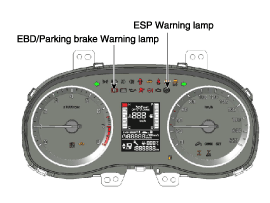Hyundai Creta: ESP(Electronic Stability Program) System / Description and operation
Hyundai Creta GS 2014-2025 Service Manual / Brake System / ESP(Electronic Stability Program) System / Description and operation
| Description of ESP |
Optimum driving safety now has a name : ESP, the Electronic Stability Program.
ESP recognizes critical driving conditions, such as panic reactions in dangerous
situations, and stabilizes the vehicle by wheel-individual braking and engine
control intervention.
ESP adds a further function known as Active Yaw Control (AYC) to the ABS, TCS,
EBD and ESP functions. Whereas the ABS/TCS function controls wheel slip during
braking and acceleration and, thus, mainly intervenes in the longitudinal dynamics
of the vehicle, active yaw control stabilizes the vehicle about its vertical
axis.
This is achieved by wheel individual brake intervention and adaptation of the
momentary engine torque with no need for any action to be taken by the driver.
ESP essentially consists of three assemblies : the sensors, the electronic control
unit and the actuators.
The stability control feature works under all driving and operating conditions.
Under certain driving conditions, the ABS/TCS function can be activated simultaneously
with the ESP function in response to a command by the driver.
In the event of a failure of the stability control function, the basic safety
function, ABS, is still maintained.
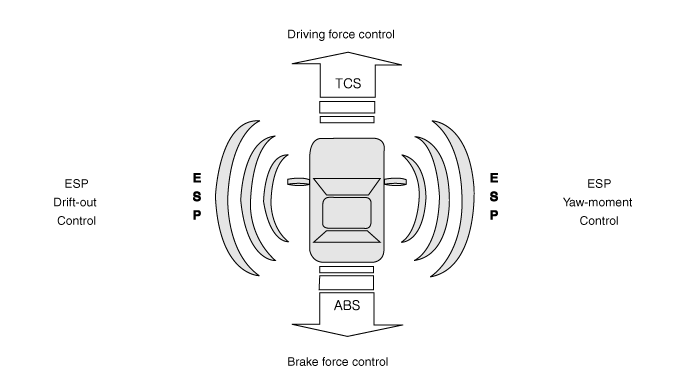
Description of ESP Control
ESP system includes ABS/EBD, TCS and AYC function.
ABS/EBD function : The ECU changes the active sensor signal (current shift)
coming from the four wheel sensors to the square wave. By using the input of
above signals, the ECU calculates the vehicle speed and the acceleration & deceleration
of the four wheels. And, the ECU judges whether the ABS/EBD should be actuated
or not.
TCS function prevents the wheel slip of drive direction by adding the brake
pressure and engine torque reduction via CAN communication. TCS function uses
the wheel speed sensor signal to determine the wheel slip as far as ABS function.
AYC function prevents unstable maneuver of the vehicle. To determine the vehicle
maneuver, AYC function uses the maneuver sensor signals(Yaw Rate Sensor, Lateral
Acceleration Sensor, Steering Wheel Angle Sensor).
If vehicle maneuver is unstable (Over Steer or Under Steer), AYC function applies
the brake pressure on certain wheel, and send engine torque reduction signal
by CAN.
After the key-on, the ECU continually diagnoses the system failure. (self-diagnosis)If
the system failure is detected, the ECU informs driver of the system failure
through the BRAKE/ABS/ESP warning lamp. (fail-safe warning)
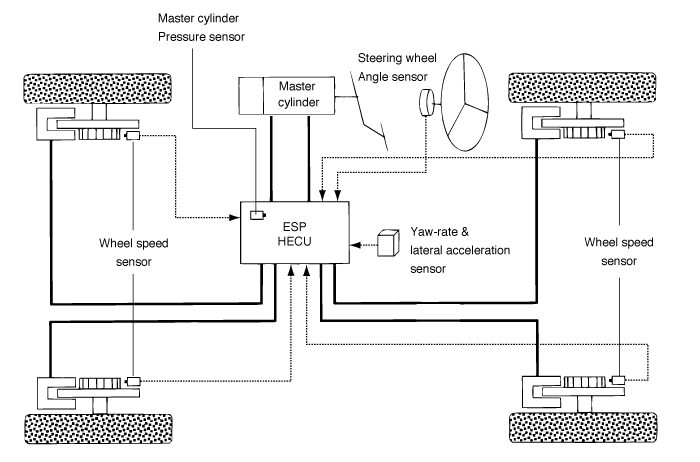
Input and Output Diagram
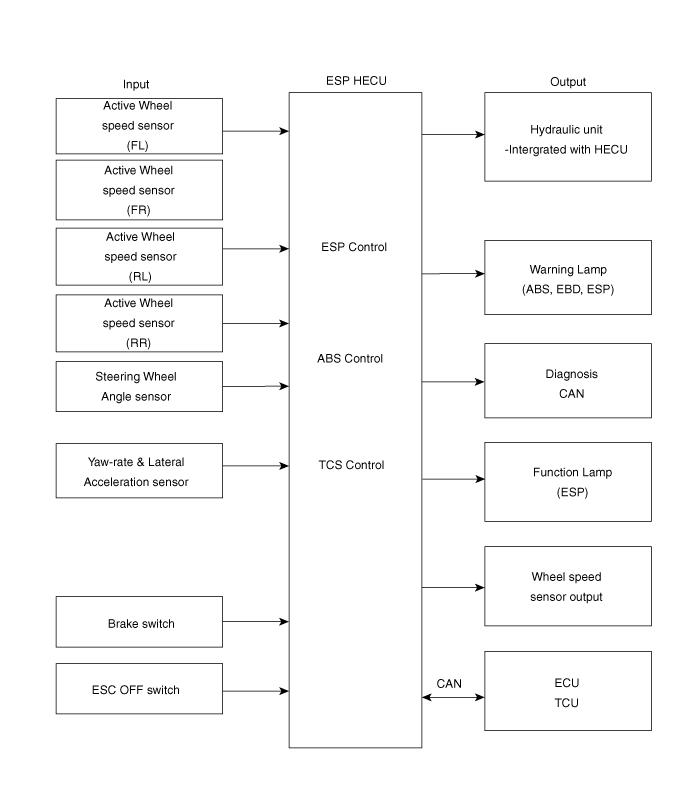
| ESP Operation Mode |
| ESP Hydraulic System Diagram |
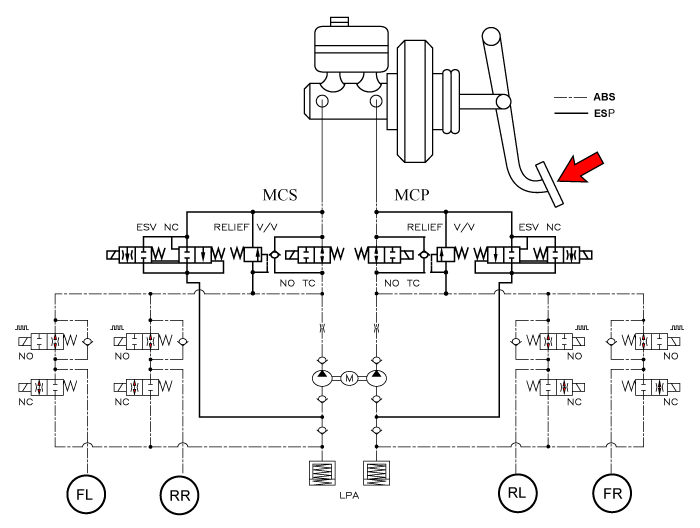
| 1. |
ESP Non-operation : Normal braking.
|
| 2. |
ESP operation
|
||||||||||||||||||||||
ABS Warning Lamp module
The active ABS warning lamp module indicates the self-test and failure status
of the ABS. The ABS warning lamp shall be on:
| ŌĆō |
During the initialization phase after IGN ON. (continuously 3 seconds).
|
| ŌĆō |
In the event of inhibition of ABS functions by failure.
|
| ŌĆō |
During diagnostic mode.
|
| ŌĆō |
When the ECU Connector is seperated from ECU.
|
| ŌĆō |
Cluster lamp is ON when communication is impossible with CAN module.
|
EBD/Parking Brake Warning Lamp Module
The active EBD warning lamp module indicates the self-test and failure status
of the EBD. However, in case the Parking Brake Switch is turned on, the EBD
warning lamp is always turned on regardless of EBD functions. The EBD warning
lamp shallbe on:
| ŌĆō |
During the initialization phase after IGN ON. (continuously 3 seconds).
|
| ŌĆō |
When the Parking Brake Switch is ON or brake fluid level is low.
|
| ŌĆō |
When the EBD function is out of order .
|
| ŌĆō |
During diagnostic mode.
|
| ŌĆō |
When the ECU Connector is seperated from ECU.
|
ESP Warning Lamp (ESP system)
The ESP warning lamp indicates the self-test and failure status of the ESP.
The ESP warning lamp is turned on under the following conditions :
| ŌĆō |
During the initialization phase after IGN ON. (continuously 3 seconds).
|
| ŌĆō |
When the ESP function is inhibited by system failure.
|
| ŌĆō |
When the ESP control is operating. (Blinking - 2Hz)
|
| ŌĆō |
During diagnostic mode.(Except standard mode)
|
| ŌĆō |
Cluster lamp is ON when communication is impossible with CAN module.
|
ESP Off Lamp (ESP system)
The ESP Off lamp indicates the self-test and operating status of the ESP.
The ESP Off lamp operates under the following conditions :
| ŌĆō |
During the initialization mode after IGN ON. (continuously 3 seconds).
|
| ŌĆō |
ESP Off lamp is On when driver input the ESP Off switch.
|
ESP On/Off Switch (ESP system)
The ESP On/Off Switch shall be used to toggle the ESP function between On/Off
states based upon driver input.
The On/Off switch shall be a normally open, momentary contact switch.Closed
contacts switch the circuit to ignition.
Initial status of the ESP function is on and switch toggle the state.
 Components and components location
Components and components location
Components
[LHD]
1. ESP control module (HECU)
2. Front wheel speed sensor
3. Rear wheel speed sensor
4. Steering angle sensor
...
 Schematic diagrams
Schematic diagrams
Schematic diagram
Terminal Function
ABS Connector Input/ Out put
Wire No.
Designation
Current12V(AMPS)
max.pe ...
Other information:
Hyundai Creta GS 2014-2025 Service Manual: Side Sill Molding: Repair procedures
Replacement
ŌĆó
Put on gloves to protect your hands.
ŌĆó
When ...
Hyundai Creta GS 2014-2025 Service Manual: Specifications
Specification
Item
Specification
Coil Resistance (Ōä”)
13.8 ~ 15.2 [20┬░C (68┬░F)]
...
┬® 2017-2025 www.hcrmangs.com


